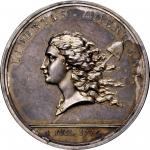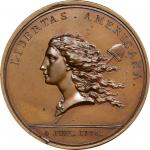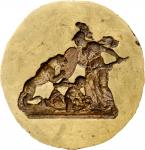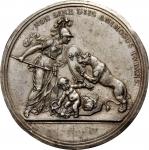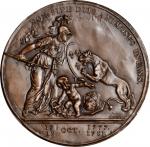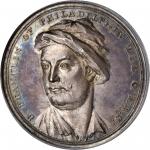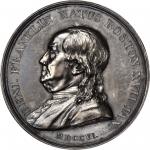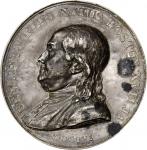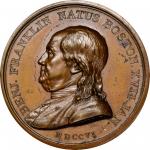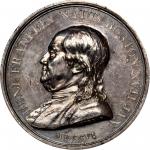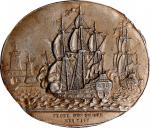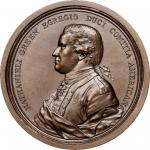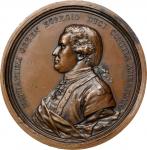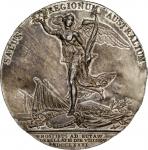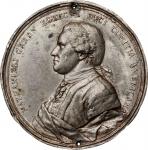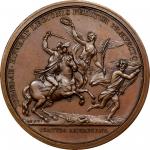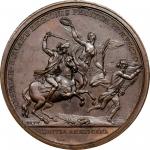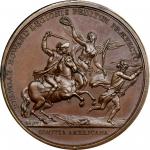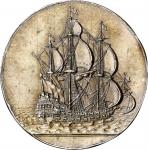1779 Flote du Conte Destain hub trial. Betts-unlisted, As Dupre No. 15, As <em>Augustin Dupre</em> (Trogan & Sorel, Musee Carnavalet) 9. White metal. Workshop of Augustin Dupre. 33.2 mm. 104.4 grains. 1.1 -1.3 mm thick. Choice About Uncirculated.Plain filed back. Glossy deep gray with the same applied browning patina to offer the appearance of copper. A different rendition of dEstaings flagship <em>Languedoc</em>, closely related to that seen on the more finished trial above, raised from an unfinished punch for this central design element. The ships angle and design are identical (though reversed). The foremast of a different, distant ship, seen at the bow of the <em>Languedoc</em>, is seen here in the same position and form as the previous trial, and all cannons, masts, and sails are identical in shape and position. The waves and exergue line are likewise substantially the same. The flags atop the masts are different, the smoke from the cannonade is not present, and no design is seen on the large flag on the stern. This trial shows circles on the base of each sail that are not present in the more finished version seen in the previous lot. A grid of scribe lines, both horizontal and vertical, are seen behind the main design, as noted on other similar progress proofs of Dupres work.<p>Dupre thought enough of this tin proof to not only save it, but treat it with the same patina he gave to the oval trial in the previous lot. Though a relative novice at engraving ship architecture, Dupre performed with great expertise here. That expertise would become useful in 1787 when the John Paul Jones commission landed on his desk.<p>These two pieces have been together since the moment of their creation, through the hands of Dupre and his descendants, the dealer intermediary who happens to be typing these words, and our consignor. There is no analogue to this piece anywhere - not in the Musee Carnavalet, nor any private collection, nor anywhere else. It is unique beyond the usual tortured declensions of that word. Its sale offers two opportunities: to either keep it united with the piece that precedes it, or to offer one more collector a chance to own a relic of the legacy of Dupres masterful but little known medal for the Comte dEstaing.<p><strong>A Note On Trials: Cliches, Epreuves, and Splashers </strong><p><p>The Adams Collection of Comitia Americana and related medals is uniquely enriched by several specimens of a unique form of medallic production that is known by several different names. Typically struck from a die in its earliest state, usually before hardening, these trials were called epreuves - proofs - in the original French correspondence between Dupre and Duvivier and the Founding Fathers charged with the acquisition of the medals the Continental Congress authorized. In more modern numismatic literature, they are more often called cliches or splashers, the latter term being a fair description of just how these trials were made.<p>Unhardened dies are incredibly susceptible to damage, as 18th century die steel (and modern steel today) is brittle before it is hardened by quenching. Once a die is hardened, modification becomes very difficult, so if changes need to be made, they need to be done in that fragile, unhardened state. Engravers in major mints - Paris especially - were accustomed to making soft metal impressions as something of a proofreading copy, enabling the negative die to be viewed in the positive in rough draft form. Wax impressions were liable to leave bits of wax in the interstices of design elements, thus engravers settled upon tin (usually called "white metal" in modern numismatic circles) as the best medium.<p><p>Tin melts at 450 degrees Fahrenheit, a low enough melting point to be accomplished in any small workshop. A ladle full of molten tin poured onto a surface will cool and harden fairly quickly, but remain soft long enough that a die can be easily pushed into it by hand, leaving a relatively durable impression in medal. Most often, medalists would find a piece of scrap paper - a note, a newspaper, a book page - to pour the tin atop, thus preventing their workspace from getting scorched and making the tin sheet somewhat easier to lift and trim. <p><p>These splashers were not intended to be medals, or even permanent, but simply a temporary way to display the state of the die in the positive before its devices were rendered immovable. Each was personally crafted by the engraver in his shop. In the case of the Comitia Americana medals, the epreuves made by Duvivier, Dupre, and Gatteaux were ultimately intended to be viewed and handled by themselves and those close to the process. Benjamin Franklin reviewed the epreuves of the De Fleury medal between April 20 and May 4, 1780, then made recommendations regarding the lettering in the obverse exergue that were adopted by Duvivier. He later did the same with his Libertas Americana medal, correcting a spelling error on the reverse. Engraver Augustin Dupre retained many of his splashers in his personal collection, some of which found their way into institutions in France and the United States, some of which are in the present sale.<p><p>Thomas Jefferson used cliches as a spendthrift (and lightweight) way to collect all the medals of the Comitia Americana series, assembling a set for himself and another for his Virginia countryman James Madison. As he was preparing to depart Paris in September 1789, he wrote to Madison to let him know of the boxes he was shipping, including a box of books and several crates full of Houdons John Paul Jones busts that the sitter wanted to have distributed in America. <p><p><em>I have put a collection of the proofs in tin of the medals voted by the U. S. (except two, of which the dies are in America) the medals themselves not being allowed to be taken, I desired the workmen to let me have two sets of their last proofs; for their manner is, as their work proceeds, to make impressions of it in pure tin, in order to correct &c. These proofs are in fact more delicate than the medals themselves, and the last of them shew the impressions complete. I have had them arranged in a frame, under glass &c. & beg your acceptance of them.</em><p><p>By "delicate," Jefferson did not mean fragile, but well-detailed. The modern whereabouts of these sets are unknown; it is very possible that some proportion of either of these sets are in the current sale.<p><p>Jeffersons set left Monticello in February 1798 in the hands of an enslaved man named York, who Jeffersons son-in-law and overseer, the abusive drunkard Thomas Mann Randolph, called "allmost (sic) an idiot." Randolph told Jefferson that the thief had confessed, listing off an inventory of items from Jeffersons chambers including "some impressions in lead & tin of Dies of the Medals & Coins." He continued "I have some hope of recovering the proofs of Medals (tis from the description I conclude they are out) I have traced one to a Negroe of the neighbourhood who bt. it of York but he says he has lost it." The historical record on the theft and recovery thereafter falls silent; Jefferson wrote several consecutive letters to Randolph after the receipt of this letter but never acknowledged the incident. Two different men named York were enslaved by Jefferson concurrently, one of whom was inherited from the estate of Jeffersons father-in-law in 1774 and described as a "Waterman," the other of whom was born in 1781 and labored at Monticello. Presumably the York involved here was the latter of these two, aged 17 at the time of his act of resistance against Jeffersons authority.<p><p>Today, cliches of each of the Comitia Americana medals are extremely rare, with populations in the low single digits. There is not a single issue in this format that is known to the extent of 8 or 10 pieces. Matched sets of obverse and reverse are the exception rather than the rule. Each of the survivors is an accident, a piece that was made to serve a purpose at a moment in time, not produced for long-term preservation in a cabinet. Their historicity is exceptional, as each survivor was not only in the hands of the medals engraver, but likely in the hands of Thomas Jefferson, Benjamin Franklin, David Humphreys, or a small number of others. Their rarity surpasses that of their normally struck cognates in nearly every circumstance.<p><p>With the possible exception of the Charles Senter Collection, sold at auction in 1933, no cabinet has ever included such a wide array of these historic rarities as the John Adams Collection.<p><strong>Dupres Medal for the Comte DEstaing</strong><p>There is little known about the history behind Dupres never-produced medal for the Comte dEstaing, but dEstaings role in the American Revolution is well documented. An infantryman and administrator for decades before he ever became a naval officer, dEstaing was promoted to vice admiral of the Asian and American seas by King Louis XVI in 1777, during the heat of the American Revolution. As soon as France officially joined the American war effort against the British, dEstaing sailed out of his home port of Toulon ready to inflict damage on the Royal Navy. The French Alliance required two principal roles for France: financing and naval support. DEstaing was the commander behind the latter.<p>DEstaing helped blockade New York Harbor in July 1778, then sailed for Newport, Rhode Island, for the abortive attack of British positions on Aquidneck Island. After a storm forced him into port for repairs, dEstaing headed south for the winter, where he performed admirably in his best known actions of the war. While he was not able to keep the British from claiming the French island of St. Lucia, he captured English positions at Grenada and St. Vincent with the help of the newly arrived Comte de Grasse, who brought ten more ships to assist dEstaing in his West Indies attacks. <p>In the early autumn of 1779, dEstaing was in command of all forces who gathered to retake British-occupied Savannah, laying siege to the Georgia city by land and sea for an entire month. Injured in an amphibious attack on October 9, 1779, he returned to France. He died at the guillotine in 1794.<p>From the John W. Adams Collection. Acquired from John Kraljevich Americana, March 2015. Earlier, from the personal collection of Augustin Dupre; Dupre Estate; Narcisse Dupre, by descent, January 1833; Augustin Dupre (grandson of the engraver), by descent; legatee of Augustin Dupre II and their descendants, by descent; Bonham’s sale of the Archive of Augustin and Narcisse Dupre, April 2014, lot 1.

